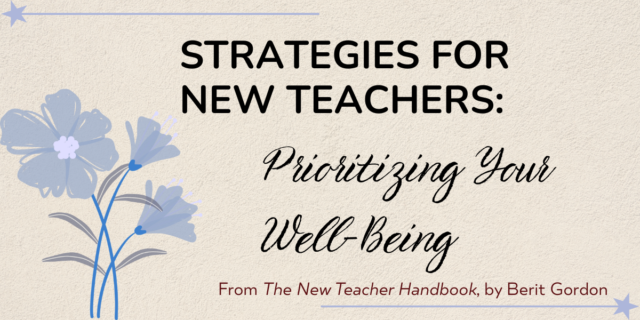
The following is adapted from The New Teacher Handbook by Berit Gordon.
How do I connect with families and gain their trust and support?
It’s easy to put connecting with students’ families on the back burner during the tiring weeks of your first year, especially for those teaching multiple classes. It’s still worth doing, though. Schedule at least 15-30 minutes a week to reach out, listen to, and connect with caregivers, and it will pay off in so much saved time and angst later.
- Create your contact list. Collect this information in a shared Google Form or a class email: “Please share the name, relationship, and preferred contact information for each caregiver you would like included in regular communication.” Make a confidential spreadsheet of these preferred names and contact info and add them to your distribution list on the school portal.
- Establish neutral or positive contact right away. Protect the essential task of communicating with a weekly appointment in your calendar at the beginning of the year. If caregivers are present, go to arrival or dismissal one or two days a week. Greet them, learn their names, and jot any relevant notes (name pronunciations, new information you learned about their child). Nothing is as powerful as being face-to-face, but any outreach is better than none. If most caregivers aren’t at arrival and dismissal, go through your roster to make phone calls during the first weeks of school. Leaving voicemails is fine (and, happily, quick).
- Be straightforward. Keep it simple: introduce yourself, welcome future contact from them, and if you can, share one positive detail (a big bonus). “Hi, my name is X. I’m happy to be your child’s teacher this year. I’m reaching out to introduce myself. You’re essential to [student’s name]’s learning and growth, and I look forward to working together across the year. If you’d like me to know anything about [student’s name], please share now or at any time.”
- Be genuine and warm, because caregivers will feel it. See caregivers as essential contributors to their child’s education. Say this and mean it. Don’t judge their absence if caregivers don’t respond, attend events, or contact you. Offer to fill them in if you can. Consider that a lack of engagement may reflect an adverse history as a student or caregiver or simply a demanding life and that they may have valid reasons for opting out of communication. Caregiver response or lack thereof is not personal, and it can take many repeated gestures and outreach before some believe your good intentions and feel comfortable responding.
Your school may have a preferred form of communication. Otherwise, choose the best method for you. Reaching out is always better than not, regardless of the format.
- Phone calls allow your warm tone to shine through. Also, parents may offer more honest communication when speaking directly, you can clarify things on the spot, and calls can prevent a lot of back-and-forth. If you send a brief email beforehand to alert them you’ll call, they’ll be more likely to answer, and it will prevent them from being caught off guard.
- Emails allow both of you to compose thoughts with more time. You also have a clear record of what was said. Emails also allow you both to respond when it’s convenient versus waiting for that often-elusive mutually compatible time.
How do I talk to a caregiver about their child’s behavior?
Reach out when you are rested, fed, and calm. Also, wait until you have enough time for a back-and-forth conversation or to reread your email before sending it. A phantom obligation can come in handy if you find yourself in a tense call and need to regroup before continuing.
- When you reach out, have specific notes to refer to, and rehearse them before calling. Don’t downplay your observations because you are new to teaching. Refer to specific facts and trust that those are valid. Assume good intentions and have good intentions. Parents likely struggle with this behavior at home, too, even if they sound defensive. Remind yourself that you are calling to work with them and to honor that the caregiver knows the student best. They’re much more likely to support you if they feel listened to and when their child and parenting are not criticized. (The behavior is your concern, not the child.)
Remember these general guidelines:
- Start with a genuine, positive observation. Don’t make this perfunctory. Make sure they hear it. Hopefully, you had the chance to reach out earlier in the year with a positive observation. This communication will go so much better if you did! Regardless, start now with something positive.
- When you share your concern, limit it to one or two specific behaviors and state what you’ve noticed as facts only, without evaluative language.
- Ask questions and listen.
- Keep the focus on finding a solution.
- Have a follow-up plan, and update the caregiver within the next few days.
How do I respond to caregiver emails, especially when they’re unhappy?
It feels rotten to get an angry email. It might seem inaccurate or accusatory. So, first, try to reframe this to avoid taking it personally and having an emotional reaction. You want communication lines to stay open, to earn their support, and to maintain your sense of self. Remind yourself that you (and this caregiver) care about this student. Keep that mutual interest at the forefront. It may feel like a sad consolation prize, but this is a chance to listen, establish your shared investment in the student, and clarify misunderstandings before they escalate. Here’s how:
- Remind yourself that all teachers, even the superstars, do and will get these. It’s better to hear it from the caregiver directly than have them fume in private, possibly with your student, or go above your head.
- Try to open emails only when you feel rested and calm. Avoid opening emails late at night and before students walk in the door.
- For anything other than yes-or-no questions or simple logistics, wait before responding; either a few hours, or better yet, the following day. Parents will be less inflamed, and your response will not be reactionary.
- Before sending a response, jot down your thoughts in a separate draft. If you need to vent, do this on paper or in a doc, not in an email. (Draft all emails without a recipient address so there’s no chance of sending an unfinished or emotional reply!)
- If you have doubts about anything in their or your email, talk it over and share it with a supervisor first. Any extremely inflammatory or angry email that levels accusations or concerns about an IEP or 504 might be better addressed in an in-person meeting with a supervisor present.
- Start every email by thanking them for contacting you and informing you about their concern. If applicable, state your shared goal to help and support their child. Add a closing that reiterates this sentiment. Now, save this as a template to reuse in the future.
- Do your best to restate the caregiver’s feelings. Acknowledging their point of view helps them feel heard and increases the likelihood that they’ll listen to you back.
- Briefly address the issue with a move forward and a possible solution. Suggest times for a phone call or in-person meeting if your response gets longer than a paragraph. It might feel like an added burden, but a call often cuts down on back-and-forth and misinterpretations.



